Subordinating Conjunctions: What Are They? (with Examples in Sentences)
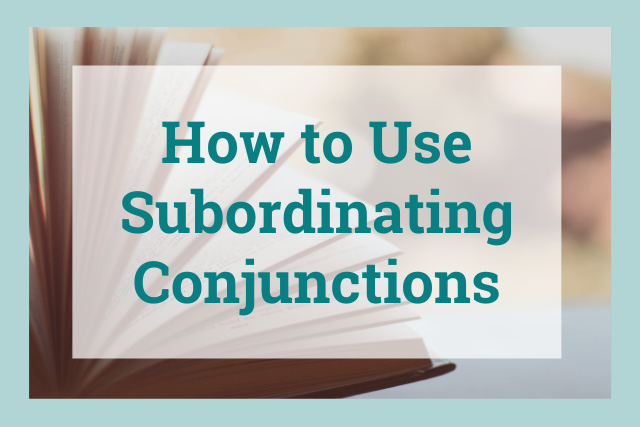
Most of us are familiar with conjunctions. These are words like and, but, and so that join other words, phrases, and clauses together. Simple, right?
Subordinating conjunctions play a similar role, just with more specific grammar rules that define when and how you can use them.
Today, we’re going to review subordinating conjunctions, with examples, explanations, and opportunities to test your newfound knowledge.
What Is a Subordinating Conjunction?
A subordinating conjunction is a word whose function is to join an independent clause with a subordinate clause.
A quick reminder:
- An independent clause can stand on its own as a complete sentence.
- A subordinate clause (aka a dependent clause) cannot stand on its own, and requires an independent clause to make a complete sentence).
Subordinating conjunctions do a few things:
Show the type of relationship (e.g. time or place–based; conditional; or cause-and-effect) between the information in a sentence’s subordinate clause and its main clause—the independent clause.
Link a dependent clause to an independent clause to create a complex sentence.
Signal the dependent clause’s subordinate status, i.e. that a subordinate clause is less important to a sentence than a main, or independent, clause.
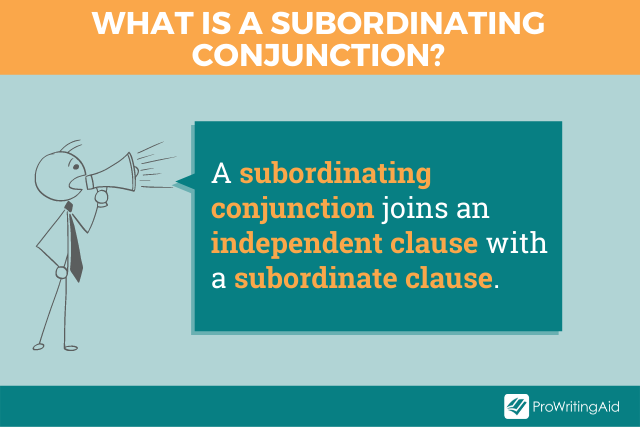
What’s the Difference Between Coordinating and Subordinating Conjunctions?
Coordinating conjunctions join phrases or clauses that are equal to each other, i.e. two independent clauses.
A subordinating conjunction joins unequal clauses, i.e. an independent and a dependent clause.
When you’re working out whether to use a coordinating or subordinating conjunction, split your sentence up into it’s main clauses. Here’s an example:
- I was a bit of a wild child [CONJUNCTION] I was younger.
"I was a bit of a wild child" can stand on its own as a sentence, while "I was younger" cannot. The two clauses are unequal, so this sentence needs a subordinating conjunction.
- I was a bit of a wild child when I was younger.
Here’s another:
- It was raining [CONJUNCTION] I didn’t have an umbrella.
In this example, both clauses can stand on their own. You need a coordinating conjunction.
- It was raining but I didn’t have an umbrella.
Examples of coordinating conjunctions are:
- and
- but
- or
- nor
- for
Let’s look at one more coordinating conjunction in a sentence:
- She wasn’t my friend, but I loaned her the money.
Notice how the phrases either side of "but" each contain complete thoughts—they are independent clauses.
The subordinate clause is the sidekick or assistant of the sentence. It adds valuable information to the independent clause it is connected to, but the independent clause doesn’t officially need the subordinate to survive as a sentence.
Before we go any further, it might be a good idea to review what independent and dependent clauses are in a little more detail.
What Are Independent and Dependent Clauses?
A clause is a group of words that contains a subject and a verb.
An independent clause also contains a complete thought, which means it has all the ingredients of a complete, simple sentence: subject, verb, and complete thought.
An independent clause is a sentence all on its own. The reader doesn’t need any other information to understand what is happening in the sentence.
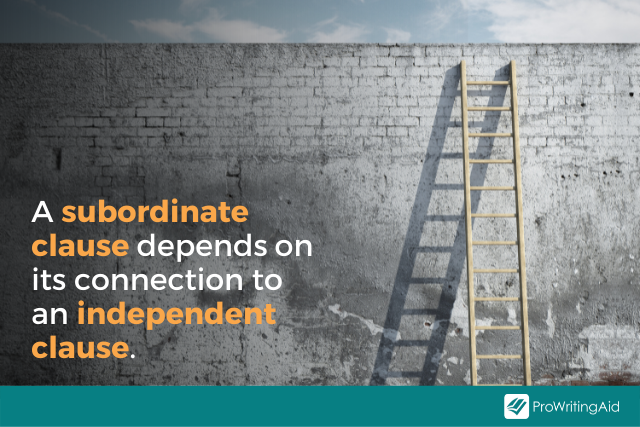
Here are some examples of independent clauses. The subjects are bold and verbs are underlined just for some added grammar review if you need it.
Shawshank Redemption is a great movie.
My son’s kitten loves to play.
The players ran up the field.
That sauce smells wonderful!
A dependent clause is also called a subordinate clause. It includes a subject and a verb, but it does not express a complete thought on its own.
It depends on its connection to an independent clause for that thought to be completed.
A dependent clause cannot stand on its own as a complete sentence.

Why Can’t You Use a Dependent Clause on Its Own?
A dependent clause is a sentence fragment—not a complete sentence. Fragments are confusing to readers because they don’t provide complete information.
For example, this sentence includes an independent and dependent clause. The dependent clause starts with subordinating conjunction after.
- After he swallowed the poison, the main character died.
Now, look what happens if I try to pass that subordinate clause off as a sentence on its own:
- After he swallowed the poison.
What happened? Did the poor guy survive? We don’t know!
Even if we still include the next piece of information as a new sentence, that still won’t make the fragment grammatically correct:
- After he swallowed the poison. The main character died.
You might say, “We just need to read the next part and the mystery is solved.”
True. But periods are full stops. When we read, we stop at periods—not forever—but they do indicate the end of the thought. Even when we keep going and read “The main character died” as the next sentence, the ideas don’t flow. They are not unified, and they need to be for that first clause to make sense.
Examples of Subordinating Conjunctions
Now that you know what a subordinate clause is, let’s return to the concept of subordinating conjunctions.
There are many conjunctions—words that link dependent clauses to independent clauses. This table includes the ones used most commonly:
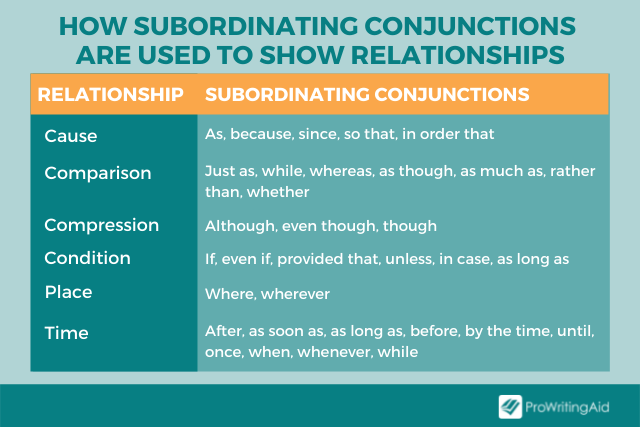
Categorizing subordinating conjunctions helps us to better understand the relationship between dependent and independent clauses
Some examples can fit into multiple categories, depending on the context of the sentence in which they are used.
How Do I Use Subordinating Conjunctions in Sentences?
To get a full understanding of what subordinating conjunctions are and how they work, it’s important to see them in action.
Check out these sentences and see if you can identify the relationship the subordinating conjunction is showing in the sentence.
And, since grammar isn’t everyone’s idea of a good time, I’ve added a challenge. All of the examples are from (or adapted from) song lyrics and poems. Can you identify the song, poem, or artist?
(I) Don’t care what is written in your history as long as you’re here with me.
Because I could not stop for death, he kindly stopped for me.
Since you’ve been gone, I can breathe for the first time.
When I’m not with you, I lose my mind.
Even though I’m leavin’, I ain’t going nowhere.
I’mma keep running cause a winner don’t quit on themselves.
Lovers think quite different thoughts while lying side by side.
When it’s cold outside, I’ve got the month of May.
Answers: 1. Backstreet Boys 2. Emily Dickinson 3. Kelly Clarkson 4. Britney Spears 5. Luke Combs 6. Beyonce 7. Maya Angelou 8. The Temptations
And here’s eight more ordinary, made-up examples so you can just concentrate on the subordinating conjunctions.
I will not start this car unless your seatbelt is buckled.
Although it is rush hour, there isn’t too much traffic.
You can have a drink in the car as long as you’re careful not to spill it!
If it’s an emergency, we can stop.
Whenever I see a rest stop, I’ll pull over for you.
Wash your hands before you leave the bathroom.
Though I’d love to say yes, the answer is no.
You may not have another drink until we get there.
All of these examples are spoken by a parent or person in charge talking to their child or another young passenger. Do you see the metaphor for main and subordinate clauses?
The driver is in charge of making the car move and getting from point A to point B, just as an independent clause is responsible for providing a sentence that conveys a complete thought.
The passenger adds to the experience of that drive, but is not necessary for making the car arrive at its destination, just as a subordinate clause (introduced by its subordinating conjunction) adds to a sentence but isn’t what makes that sentence complete.
How to Order Independent and Dependent Clauses in Your Sentences
Most of the time, you can place either the independent or the dependent clause first in your sentence and it won’t change the meaning. It’s a matter of style, or preference.
However, it is good practice to vary your sentence structure to avoid sounding monotonous. You don’t want to start too many sentences with a subordinating conjunction, just as you wouldn’t want any of your sentence styles to be repetitive.

To keep your sentence structure varied, run your work through ProWritingAid’s Structure Report. If you’re starting too many sentences with subordinate conjunctions and clauses, this report will let you know and will coach you through revisions.
Upload your writing to our editor and try the Structure Report with a free ProWritingAid account.
What Punctuation Should You Use with Subordinate Conjunctions?
Take another look at those examples from before. Pay special attention to where the conjunction appears in its sentence, and to comma placement.
Subordinating conjunctions follow these punctuation guidelines:
When the independent (or main) clause comes first and is followed by the dependent clause, no comma is required.
- See examples 1, 6, 7, 9, 11, 14, 16 from above.
When the sentence starts with a subordinating conjunction (and therefore a dependent clause), put a comma after the dependent clause, before the independent clause.
- See examples 2, 3, 4, 5, 8, 10, 12, 13, 15 from above.
If this all sounds a bit difficult to remember, download ProWritingAid’s browser extension. It’ll tell you when you’ve missed a comma, or used one when you shouldn’t have.
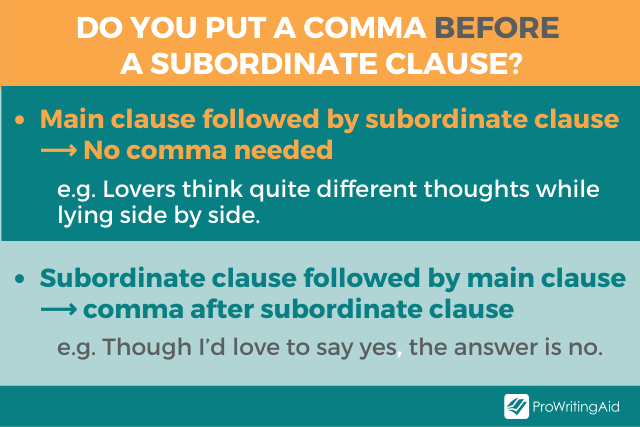
Final Review of Subordinating Conjunctions
Understanding subordinating conjunctions and the role they play in sentence structures is key to producing grammatically correct writing. Here are the key summary points that you need to remember:
- A subordinating conjunction joins an independent clause with a dependent, or subordinate clause.
- A subordinate/dependent clause does not express a complete thought on its own and so depends on connection to an independent clause.
- When the independent clause comes first and is followed by the subordinating conjunction that introduces the dependent clause, no comma is required.
- When the sentence starts with subordinating conjunction (and therefore a dependent clause), and is followed by the independent clause, put a comma after the subordinating clause.